Urinary Tract Infection (UTI)
What is a urinary tract infection?
A urinary tract infection (UTI) is a common type of infection in children. About 1-2 percent of children are diagnosed with a UTI. Each year, we treat more than 800 patients who have urinary tract infections.
Causes of UTI
The urinary tract includes the parts of the body involved in making urine: the kidneys and the bladder. A child gets a UTI when there is an abnormal growth of bacteria in the urine. The infection can either be in the bladder (cystitis) or in the kidney (pyelonephritis). Understanding the difference between the two is important because how we will manage and treat your child is different.
Signs and symptoms of UTI
Cystitis is an infection in the bladder. Symptoms include:
- Burning feeling with urination
- Needing to use the bathroom more often
- Having wetting accidents
- Pain in the lower part of the abdomen
Pyelonephritis is an infection of the kidneys, usually caused by bacteria that have traveled up the urethra, bladder and ureters. In infants and young children the symptoms include:
- High fever
- Decreased appetite
- Irritability
- Vomiting
Older children will also have:
- High fever
- Possible back pain
- Nausea and vomiting
Testing and diagnosis for UTI
If we suspect that your child has a UTI, we will ask for a urine test. The proper collection and evaluation of your child’s urine is key to an accurate diagnosis. A diagnosis cannot be made until the urine is tested. In infants or children who are not toilet trained, a catheter specimen is best.
Your child’s urine will be sent to a laboratory to see if any bacteria are growing. This is called a urine culture. It will take one to two days to get these results back. The urine culture will let us know what kind of bacteria is growing in your child’s urine, how much of that bacteria is growing, and what antibiotics will best treat your child’s infection.
Treatment for UTI
During your office visit, we will discuss which management approaches are needed for your child depending on the symptoms, the urine culture results and your child's age.
If your child has symptoms of a bladder infection (cystitis), we will focus on his toileting habits to prevent future urinary tract infections. We will ask that he empties his bladder on a routine schedule, increases the amount of water he drinks, and monitors bowel movements for any signs of constipation. In addition, we may refer your child to our DOVE Center for:
- Uroflow — To measure the urine flow rate and the time needed to empty the bladder along with an ultrasound to see if any urine is left in the bladder.
- Biofeedback training — To help children relax their pelvic floor muscles to empty their bladder fully.
- Behavior modification — To provide education as to how the body works and why children need to follow the recommendations given. Our psychologists will also discuss behavior management around toileting.
If your child has a kidney infection (pyelonephritis) we may request other imaging studies such as:
- Renal and bladder ultrasound — A noninvasive test in which a transducer is passed over the kidney producing sound waves which bounce off the kidney and bladder, transmitting a picture on a video screen. The test is used to determine the size and shape of the kidney, and to detect a mass, kidney stone, cyst or other obstruction or abnormalities.
- Voiding cystourethrogram (VCUG) — A specific X-ray that examines the urinary tract. A catheter (hollow tube) is placed in the urethra (tube that drains urine from the bladder to the outside of the body) and the bladder is filled with a liquid dye. X-ray images are taken as the bladder fills and empties. The images will show if there is any reverse flow of urine into the ureters and kidneys.
- Nuclear medicine renal scan (DMSA) — A nuclear test that gives pictures of the kidneys to see how and when they are working. An IV is inserted to inject a small solution called an isotope into your child’s veins. The isotope is what helps to create the picture of the kidney. The images of the kidneys will allow us to see if there has been any scarring as a result of your child’s recent UTI.
Depending on the results from the tests, we will find the best treatment option for your child.
Reviewed by: Division of Urology
Date: May 2011






















